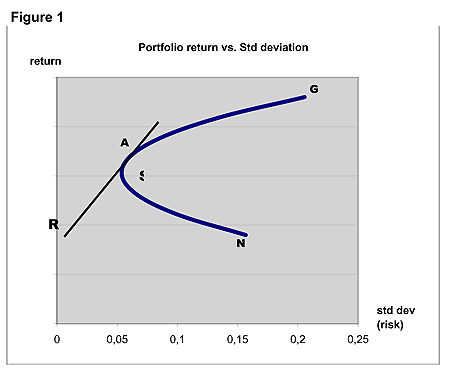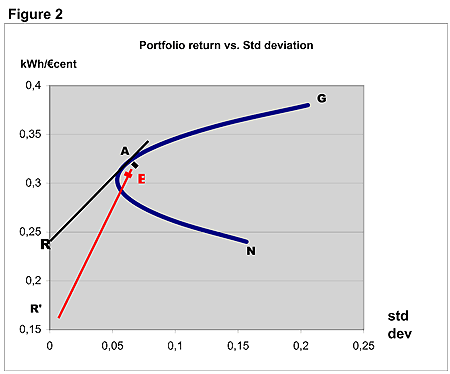
European
Nuclear Society
e-news
Issue 19 Winter 2008
http://www.euronuclear.org/e-news/e-news-19/listening.htm


The recent turmoil affecting the financial places around the world prompted me to open a report that had been left unattended on my desk for quite some time. Its title is “Applying Portfolio Theory to EU Electricity Planning and Policy-MakingI”. The term portfolio refers of course to shares and portfolio theory refers to a technique used to reduce risk when investing in shares. It is well known that the higher the expected return of a share, the riskier it will be. Portfolio theory shows how to combine shares of various risks and returns so as to achieve a better combination of risk and return that if one had invested in only one type of share. The basic idea behind this technique is that whenever different shares fluctuate differently with the stock exchange, this will reduce the overall fluctuation of the portfolio. This is illustrated by figure 1 below. Let us first concentrate on the blue curve. The end point named G is the point where one has invested 100% in high-risk, high return shares G. The end point named N represent the situation where all the investment consists in lower-risk, lower-return shares N. As one moves on the curve from G to N, the percentage of G shares decreases gradually. The point S is the leftmost point of the curve, where overall risk is minimal. The portfolios corresponding to the portion SAG of the curve are called efficient because the points of SAG lead to higher returns than the points of SN on the same vertical, i.e. characterised by same risk. If one brings in the picture low-return, risk-free securities such as Treasury bonds (point R), further improvements can be achieved. The combinations of such securities with the portfolio characterised by point A are all on line RA. Such combinations can further reduce risk as can be seen from the chart. In particular, if one considers the intersection of the horizontal line through point S with the black line: the risk attached to it is even lower than for point S although the return achieved is the same. Further details, including the basic formula underpinning the method, can be found in the above-mentioned report.

Resorting to portfolio theory when it comes to electricity planning enables one to take a broader of view of the issue. Most of the time, the various energy sources available are assessed only in terms of cost-effectiveness, i.e. in terms of the € it costs to generate one kWh. Professor Awerbuch noted that, by inverting this unit cost, one obtains kWh/€, which is akin to a return. The risk attached to such return consists of the fluctuations that can affect it and that are generated in the main by the cost of fuel. Fig 1 can now be re-interpreted in this new context and the insights of portfolio theory should be easy to apply to energy if one considers N and G as standing for nuclear and gas respectively. Can point R, which corresponds to a zero risk stand for renewables? Yes says the report, because when it comes to wind and solar energy, the fuel is free and its cost is therefore not subject to fluctuations. This is why the authors see in renewables a perfect equivalent to Treasury bonds and they proceed to draw all the lessons of portfolio theory to define an efficient energy mix for the EU. The outcome of this exercise is that one ends up with energy portfolios where nuclear energy and renewables dominate a small proportion of gas and coal. The authors repeatedly noted that high proportions of wind energy cannot be taken for granted due to its interruptible nature (notes 38, p22, 56 p28 and 76, p38) but they did not take the step of trying to assess the impact of this constraint on their conclusions. This is however a serious departure from the financial portfolio model. After all, Treasury bonds do not provide their return part of the time only. Furthermore, energy planners differ from investors in another way: the former also set themselves the goal of being able to achieve a given peak power with a high level of confidence. To match this constraint, investors would have to be able to achieve a peak income at given times during the investment period, which is obviously not taken into account by portfolio theory.
Out of interest, I asked myself how this shortcoming could be overcome and quickly found out that it is far from being straightforward. The abovementioned constraints do not easily lend themselves to modelling: the need for continuity of supply is not easy to express in the return/standard-deviation plane; the required minimum energy return introduces an absolute value in a problem where all others are relative. One possible way consists in noting that in the future, higher proportions of renewables will require the provision of specific back-up generating capacity to make up for their low availability. This back-up would be provided by non-interruptible sources or, perhaps, by additional wind capacity spread over large areas. In either case, the expected return will be lower than the one considered in the reportII. The consequences could be illustrated with the help of Figure 2.

Instead of having line RA, we would be confronted to something like line R’B. Should the orders of magnitude represented be correct, the following consequences would follow:
The risk reduction one can expect with a return of renewables equal to R’ is less than what could be obtained with R as can be easily ascertained by comparing the respective positions of the points on lines RA and R’B.
Likewise, including a large proportion of wind in the energy mix would reduce the return of the energy mix to a noticeably larger extent than is assumed in the report on the basis of too optimistic figures for wind generation.
Alternatively, one might consider that the fuel risk borne by the back-up capacity
needed by wind is to be ascribed to the latter. Point R would the leave the
zero-risk vertical and move to the areas of positive standard deviation,
with an effect similar to the move of R to R’.
Does all this mean that the wind option should be abandoned? Certainly not, but it does mean that overlooking one single basic fact can seriously alter the conclusions of an otherwise rigorous analysis. The devil is indeed in the details.
I This report, dated February 2003, was written by the late Prof. Shimon Awerbuch and co-authored by Martin Berger. It can be downloaded from www.awerbuch.com
II The figures used in the report date back to 2000, a time when the small proportion of wind energy in the overall mix did not imply specific back-up capacity.
![]()
© European Nuclear Society, 2008